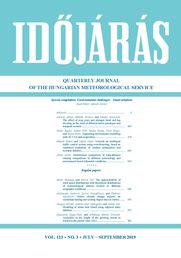IDŐJÁRÁS - angol nyelvű folyóirat
Vol. 123, No. 3 * Pages 265–408 * July - September 2019
 |
Special compilation: Environmental challenges – Smart solutions |
 letöltés [pdf: 3299 KB]
letöltés [pdf: 3299 KB]
The effect of crop years and nitrogen basal and top dressing on the yield of different maize genotypes and marginal revenue
Adrienn Széles, Kálmán Kovács, and Sándor Ferencsik
DOI:10.28974/idojaras.2019.3.1 (p. 265–)
Adrienn Széles, Kálmán Kovács, and Sándor Ferencsik
DOI:10.28974/idojaras.2019.3.1 (p. 265–)
Supporting microclimate modeling with 3D UAS data acquisition
Zsófia Kugler, Zoltán Tóth, Zsuzsa Szalay, Dóra Szagri, and Árpád Barsi
DOI:10.28974/idojaras.2019.3.2 (p. 279–)
Zsófia Kugler, Zoltán Tóth, Zsuzsa Szalay, Dóra Szagri, and Árpád Barsi
DOI:10.28974/idojaras.2019.3.2 (p. 279–)
Towards an intelligent traffic control system using crowdsourcing, based on combined evaluation of weather information and accident statistics
Mátyás Szántó and László Vajta
DOI:10.28974/idojaras.2019.3.3 (p. 295–)
Mátyás Szántó and László Vajta
DOI:10.28974/idojaras.2019.3.3 (p. 295–)
Performance comparison of long-distance running competitions in different meteorology and environment based influential conditions
David Berke
DOI:10.28974/idojaras.2019.3.4 (p. 313–)
David Berke
DOI:10.28974/idojaras.2019.3.4 (p. 313–)
Approximation of wind speed distributions with theoretical distributions of meteorological stations located in different orographic conditions
István Hadnagy and Károly Tar
DOI:10.28974/idojaras.2019.3.5 (p. 329–)
István Hadnagy and Károly Tar
DOI:10.28974/idojaras.2019.3.5 (p. 329–)
Future climate change impacts on residential heating and cooling degree days in Serbia
Aleksandar Janković, Zorica Podraščanin, and Vladimir Djurdjevic
DOI:10.28974/idojaras.2019.3.6 (p. 351–)
Aleksandar Janković, Zorica Podraščanin, and Vladimir Djurdjevic
DOI:10.28974/idojaras.2019.3.6 (p. 351–)
Modeling of urban heat island using adjusted static database
Gergely Molnár, András Zénó Gyöngyösi, and Tamás Gál
DOI:10.28974/idojaras.2019.3.7 (p. 371–)
Gergely Molnár, András Zénó Gyöngyösi, and Tamás Gál
DOI:10.28974/idojaras.2019.3.7 (p. 371–)
Anomalies in the length of the growing season in Poland in the period 1966–2015
Katarzyna Szyga-Pluta and Arkadiusz M. Tomczyk
DOI:10.28974/idojaras.2019.3.8 (p. 391–)
Katarzyna Szyga-Pluta and Arkadiusz M. Tomczyk
DOI:10.28974/idojaras.2019.3.8 (p. 391–)
IDŐJÁRÁS folyóirat

Az IDŐJÁRÁS a HungaroMet Nonprofit Zrt. negyedévenként megjelenő angol nyelvű folyóirata
Megrendelhető a journal.idojaras@met.hu címen.
A szerzőknek szánt útmutató itt olvasható.
Megrendelhető a journal.idojaras@met.hu címen.
A szerzőknek szánt útmutató itt olvasható.









